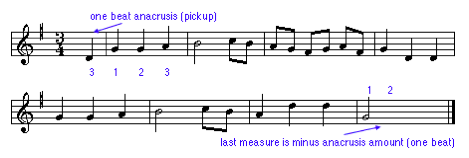 |
|
 |
 |
 |
 | Modern composers have frequently made use of meters that have an odd number of subdivisions, which means that the measure cannot be divided into equal beats. These meters are called asymmetrical meters. Although there have been a number of different methods of notation used throughout the twentieth century, the traditional method of notating these time signatures is frequently used.
This type of meter is easy to recognize, since the top number is an odd number. Asymmetrical meters may behave like simple or compound meters, however, if the lower number is 2 or 4, it usually will behave like simple, if 8 or greater, it usually will behave like compound. In order to determine the beat groupings, however, one must pay careful attention to the beams indicated in the music.
|
 |
 |
 |
 |
 |
 |
Notice also that the meter may change in the middle of a work in any measure. The new time signature remains in effect until the end of the piece or another time signature occurs.
It is also important to note that there may only be as many beats in a measure as the time signature allows. In 2 - 4 there should be exactly 2 quarter notes total in each measure.
The only exceptions are when a composer notates a cadenza, which is a free, non-metered solo, or in the very first and last measures of a piece. Sometimes, rather than beginning the first measure with rests, composers will use an anacrusis or pick up. When this occurs, the last measure of the piece must be reduced by the total rhythmic value of the anacrusis, so that the entire piece has a full number of beats that matches the meter(s) employed.
|
 |
 |
|


 |
 |
 |

